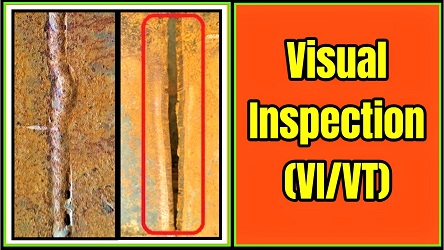Browsing Welding Inspection Gilbert Arizona: Essential Insights for Sector Professionals
Browsing Welding Inspection Gilbert Arizona: Essential Insights for Sector Professionals
Blog Article
Checking Out the Importance of Welding Assessment in Industrial Applications: Securing Against Failures and Enhancing Long Life
Welding evaluation functions as a crucial line of protection in commercial applications, ensuring the structural honesty and dependability of bonded parts. By systematically recognizing issues such as porosity and incomplete combination, assessments not only protect against failures yet also prolong the life expectancy of important properties. Complying with sector criteria enhances both safety and operational performance; nonetheless, the ramifications of disregarding these techniques can be serious. As we take a look at the diverse benefits of routine examinations, it comes to be noticeable that understanding these dynamics is not just an issue of conformity yet a strategic imperative for longevity and risk reduction (Welding Inspection Gilbert Arizona).
Function of Welding Evaluation
Welding inspection functions as a crucial guard in industrial applications, making sure that bonded frameworks satisfy specified criteria of top quality and security. This process entails a methodical evaluation of welds to validate their stability, stamina, and conformity with well established codes and specs. The duty of welding assessment is multifaceted, including both aesthetic assessments and non-destructive screening techniques, which may include ultrasonic, radiographic, or magnetic particle testing.

Additionally, welding assessment plays a crucial role in regulative conformity. Numerous sectors are governed by rigid safety and security standards, demanding extensive documents and validation of welding methods. By preserving these documents, companies can demonstrate adherence to security guidelines, thereby cultivating depend on amongst stakeholders and clients. Eventually, the duty of welding inspection is essential in advertising safety and security, enhancing performance, and safeguarding financial investments in commercial framework.
Typical Welding Defects

One of the most prevalent defects is porosity, characterized by tiny gas pockets caught within the weld steel. This occurs due to contaminants or inappropriate securing gas, jeopardizing the weld's stamina. Another considerable defect is incomplete fusion, where the weld steel stops working to bond correctly with the base material, possibly resulting in architectural weaknesses.
Cracks can also create throughout or after the welding process, frequently attributed to thermal stresses or inappropriate air conditioning rates. Additionally, damaging, where the base metal is deteriorated along the weld grain, can weaken the joint and is usually triggered by extreme heat input or wrong method.
Furthermore, absence of infiltration happens when the weld steel does not reach the origin of the joint, resulting in inadequate stamina. Comprehending these typical issues is important for examiners and welders alike to ensure that bonded frameworks satisfy security and performance standards, ultimately stopping potential failures in industrial applications.
Benefits of Normal Assessments
Routine assessments function as a vital guard in making sure the integrity and long life of bonded frameworks. These analyses identify possible issues and weak points that might jeopardize the honesty of welds, permitting timely remediation prior to concerns intensify. By implementing an organized assessment routine, organizations can considerably decrease the threat of tragic failings that might cause expensive his response downtime, equipment replacement, or perhaps accidents.
Additionally, routine evaluations add to boosted quality assurance throughout the welding procedure. By adhering to a consistent examination routine, firms can guarantee that their welding methods meet well established quality benchmarks and best techniques. This not just fosters a society of responsibility but additionally motivates continuous enhancement among welding employees.
Additionally, routine inspections help with much better upkeep planning. By recognizing deterioration early, companies can purposefully schedule fixings and replacements, reducing disruption to operations. This positive approach eventually results in extended asset life expectancy and enhanced general performance.
Finally, a commitment to routine assessments can improve a business's credibility in the market. Customers and stakeholders significantly worth companies that focus on security and quality, therefore boosting trust fund and possibly leading to enhanced organization possibilities.
Market Criteria and Regulations
Abiding by industry standards and policies is an essential element of welding evaluation that enhances the advantages of regular assessments. These standards, established by companies such as the American Welding Culture (AWS) and the American Society of Mechanical Designers (ASME), supply a framework for ideal methods in welding procedures, materials, and inspection strategies. Conformity with these policies ensures that welds satisfy the required top quality and click site security benchmarks, considerably decreasing the threat of structural failings.
Regulative bodies like the Occupational Safety and Wellness Administration (OSHA) better impose guidelines that shield employees and the environment throughout welding operations. By following these developed requirements, industries can improve the dependability of their frameworks and parts, guaranteeing they do as meant under numerous functional conditions.
In addition, adherence to market standards cultivates consistency in quality control, assisting in smoother communication among stakeholders and regulative companies. This placement not just reduces responsibility dangers yet also boosts the reputation of organizations in open markets. Inevitably, conformity with welding criteria and guidelines is not merely a legal commitment; it is an important investment in security, efficiency, and long-term functional success.
Future Trends in Welding Examination
As industries remain to progress, the future of welding assessment is poised to incorporate sophisticated innovations that enhance precision and efficiency. Among the most considerable patterns is the adoption of automation and robotics in assessment processes. Automated systems can perform evaluations rapidly, decreasing human error and increasing throughput in manufacturing environments.
Furthermore, the combination of fabricated intelligence (AI) and artificial intelligence formulas will certainly allow anticipating analytics, enabling for real-time analyses and positive maintenance (Welding Inspection Gilbert Arizona). By assessing information from previous inspections, these innovations can determine patterns that could suggest prospective failures, thus extending the lifespan of bonded parts

Furthermore, the trend towards digitalization will certainly bring about boosted data management systems that facilitate better tracking, reporting, and compliance with industry more helpful hints requirements. In recap, the future of welding inspection is characterized by technological developments that promise to substantially boost dependability, safety and security, and functional performance in numerous commercial applications.
Conclusion
Finally, welding examination serves a vital function in guaranteeing the stability and longevity of bonded frameworks across different commercial applications. By recognizing flaws such as porosity and insufficient combination, routine evaluations play a significant role in risk reduction and quality control. Adherence to industry requirements and regulations even more boosts functional safety and integrity. As innovations in modern technology continue to progress, the future of welding assessment guarantees increased precision and performance, eventually adding to the long life of important frameworks.
Welding examination serves as a crucial line of protection in industrial applications, guaranteeing the architectural integrity and integrity of welded elements.Welding inspection serves as an important safeguard in industrial applications, making sure that welded frameworks meet defined standards of high quality and safety and security - Welding Inspection Gilbert Arizona. Inevitably, the role of welding evaluation is vital in advertising security, boosting efficiency, and protecting investments in industrial infrastructure
These standards, established by companies such as the American Welding Culture (AWS) and the American Culture of Mechanical Designers (ASME), provide a structure for best practices in welding processes, products, and examination techniques.In verdict, welding inspection offers a vital feature in making certain the stability and sturdiness of welded structures across various industrial applications.
Report this page